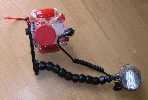I only recently started to get into digital photography. My first setup was an MX10. It's a film based, point and shoot camera made by Sea and Sea. I managed to get some reasonable shots, but it was a bit limited because it's fixed focus. Scanning in photos for the website is also a bit tedious, and I found that camera shops aren't always very good at developing underwater images. So I decided to go digital.
My first choice was going to be a Canon G5, but Canon don't do an underwater housing and 3rd party ones are very expensive, so I opted for an Olympus. They produce housings for all of their consumer cameras and they're rated to 40m. They'd just brought out their 5060 model, so I went for that. I bought it from Camera Depot who seemed to be the cheapest at the time.
For the housings, there was actually two choices. There was the Olympus PT-020 and one made by Ikelite. The Ikelite one was only just becoming available and it's a lot more expensive at around £450. At the time, the only people who had the PT-020 in stock were Cameras Underwater so I ended up paying through the nose for it. I paid £199. You can now get them for £135 if you shop around.
The next choice was which flash to go for. Olympus sell the FL20 and an underwater case for it, which provides full TTL, but with a guide number of 20, it's not the brightest flash in the world. My other option was to go for a digital adaptor. I found what I was looking for on Matthias Heinrich's site. The adaptor comes in two parts. One part slots into the hotshoe inside the case. The second part is attached to the outside and the strobe. The two parts communicate to each other via infrared.
The only problem was that no-one had yet tried this system with the 5060, only the 5050, so we weren't sure how I could attach it to the housing. Matthias offered to send me an adaptor to try and then I could pay him if it worked OK.
There are two versions of the digital adaptor. One for Sea and Sea based strobes and one for Nikon based. The YS-60 comes in both variants, but at the time Cameras Underwater were selling the Sea and Sea one at a reduced price of £179. So I went for that, plus a 10Bar flexi arm and slot stay.
It was obvious that the best way to attach the adaptor was to use the flash shoe on the outside on the PT-020 case. The screws attaching the two metal bars don't go all the way through, so there was no risk of leaking. So I removed them. I then cut a rectangle of plastic from a Pantene shampoo bottle. I made 4 holes in it for the screw positions and 6 larger hole to put cable ties through. I screwed the metal bars back down on top of the plastic rectangle and then pushed tie wraps through the other holes and secured the adaptor to it. It looks a bit Heath Robinson, but it does the job.
 |
 |
 |
I found that you have to be a bit careful lining up the outside part of the adaptor with the part inside. If you don't either the strobe doesn't fire or, more often, it fires at full power and over illuminates the subject. Once you've got it lined up though, it works well.
My first real test was during my trip to Ranveli in the Maldives. After a bit of trial and error, I set the camera up to a My Mode based on Program Mode with the flash always on, underwater case accessory set and in macro mode. You can change everything underwater anyway, so switching to super macro mode when necessary isn't a problem, though I find the controls a bit counter intuitive. You have to hold the focus button down and then turn a wheel to change it, so it requires two hands and for the first week I always seemed to turn the wheel the wrong way.
Over the 2 weeks, I took in excess of 500 shots on 16 dives. A lot of them were complete rubbish, but with digital, it doesn't matter. I found that I was getting 3 dives out of a charged battery. I had the camera on for about 45 minutes on each dive and generally took about 30-40 pictures. With a 512MB Compact flash card, you can get over 200 pictures in JPEG highest quality mode. The camera also accepts xD cards, but as they are more expensive and slower, I can't really see the point.
One of the big selling points of the 5060 is its relative fast shutter speed for a camera in its class. However, there's still quite a delay between pressing the shutter and the picture being taken. This is down to the auto focus system, which is slowest in poor light. I found that if I was trying to take pictures of clownfish, all I could do was snap at random and hope the fish was in a good position. That aside, I was pleased with the results and it was certainly a big improvement on what I managed with the MX10.
